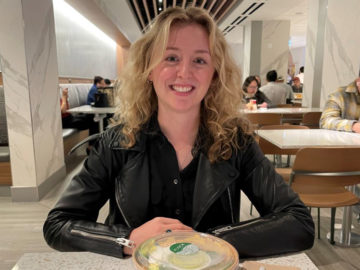Managing Allergies
Home from College, Only to Face Food Allergy Perils
With COVID-19, we were sent home from college to study virtually and stay safe. But it was a shock to learn that nuts had become a staple of my family's pantry. Under our own roof, as an allergic person, I was suddenly on high alert.
My dorm room was still dark when my phone lit up with a call from a friend. I answered with a groggy “hello,” but her grave tone jolted me out of my sleepy stupor. She broke the news: we had fewer than five days to be packed up and off campus. Music filled the streets, students emerged from midterm exams crying, and friends hauled moving boxes into dorm buildings.
Like thousands of other college students across the nation, in March, COVID-19 forced an abrupt end to my sophomore year. I was heading back to my childhood home in Illinois. It was disheartening to miss out on the campus experience, but I also recognized the potential for some quality time with my family.
Sure enough, the last six months have been filled with bike rides with my dad, book clubs with my brother, board-game victories, a binder of new recipes, and virtual internship opportunities.
COVID-19 has brought unexpected joys and unexpected challenges. One big challenge has been trying to readjust to living with my family full-time. With online college classes starting this month, I will be staying in Illinois for the foreseeable future. Adapting has turned out to be about much more than just my independence, it also relates to feeling safe – under my own family’s roof.
Food Allergy Vigilance – At Home?

I had been gone for two full years, either in Massachusetts at Harvard, or studying abroad in Spain. It seems that in that time, my family members forgot what it was like to live with someone that has a severe food allergy. Checking food labels for “May Contain… ” or “Processed on the same equipment…” statements had become a distant memory. Without a food allergy in the house, habits and tastes had shifted.
As someone who is severely allergic to tree nuts, it was unnerving to discover that the family’s weekly grocery list had been updated to include Nutella, risky whole wheat bread, cross-contaminated snack bars, and jars of nuts. My sister and mom like to eat the “100 Calorie Packs” of almonds as an afternoon snack, and my brother likes a certain granola bar that “may contain tree nuts.” When my dad runs to the grocery store on the corner for an extra gallon of milk or carton of eggs, he also likes to bring home some candy – a dozen chocolate pecan “Turtles”.
My sudden return home disrupted my family’s food routines, while I came to grips with the idea of being face-to-face with my allergens every day. Even small bits of tree nuts can send me into anaphylaxis, the severe form of food-allergic reaction, so I had to be on high alert.
Not So “Sweet” Treats
As if to drive home that fact, a few weeks into quarantine, a family friend dropped off a mountain of almond biscotti as a gift. Like ravenous beasts, my three younger siblings swooped in to devour as many slices as possible. I watched the crumbs scatter on the ground, the table, and the counter. As he munched on an almond-encrusted piece, my 10-year-old brother spewed a few crumbs as he asked, “Wait, so you can’t, like, eat these?”
It was the perfect teaching moment. I went to my bedroom, retrieved my epinephrine auto-injectors and antihistamines, and returned to the kitchen table. I demonstrated how to inject my EpiPen into my thigh, explained the symptoms of anaphylaxis, and described the danger of having crumbs of almond biscotti laying around.
After hearing about the grave risks to me, my brother suggested we throw the rest of the crunchy dessert away. “It’s not that good,” he noted. Although I appreciated the offer and the sentiment, I instead simply asked him to be more careful while eating the biscotti. For the next week, I found myself disinfecting the kitchen table and the counters in my own house – more in fear of almonds than COVID-19.
Oops, Don’t Eat That!
About a week later, we were all craving some ice cream. My dad took the plunge and masked up to drive to the nearest grocery store to buy some. He returned with a quart of vanilla and another quart of chocolate. Each was a brand that I did not recognize. I picked up the vanilla and my heart sank as I read the “May Contain” list on the package, its bolded warnings almost a paragraph long. It listed several types of tree nuts. Clearly, I couldn’t eat it.
I pointed out that he had purchased ice cream that was unsafe for me. He immediately apologized: “Oh no! I totally forgot to read the label! I am going back out; I’ll buy you your own special ice cream.” Despite my protestations that this wasn’t necessary, he got back in the car and drove to buy me my own quart of safe ice cream.
Getting Ground Rules
With me living away, nut allergy awareness had slipped from being second nature, even for my parents. After more instances like these, our family decided that we needed to lay down some ground rules for shopping and eating foods around the house. To live without fear in my own home, I respectfully required that a few rudimentary rules to be followed. For instance, if one of my family members ate a product with nuts, they were required to use a dish at all times while eating to avoid excessive crumbs, wash their hands right after eating, and thoroughly clean the affected area.
We agreed that the family could continue to purchase certain products (risky wheat bread, granola bars, etc.) but limit the purchase of other foods that are outside my comfort zone (Nutella, bags of loose pecans, almond butter). If a family member wanted to purchase an unsafe food that was meant to be shared, we vowed to also buy a safe alternative, so I wasn’t left out. We all recommitted to taking those extra few moments to read the labels when purchasing new foods.
In a time of the COVID-19 pandemic, I’d been sent home from college to live and study safely. The irony is that coming home was accompanied by a re-learning curve for my family – just to keep me safe from a completely different severe medical condition. Both my family members and I have learned the value of being flexible and of communicating, all while keeping safety as a priority. In challenging times, we found the ways to make home the safe haven that it has to be.
Alexa Jordan is a rising junior at Harvard University. She can be found at @alexa.jordan on Instagram.
Related Reading:
Dating in College With Food Allergies
Safe at School: Navigating COVID-19 and Food Allergies
In Class or Virtual: Allergy Families Grapple with School’s Return
Main Stock Photo: Getty Images


